Is it getting harder to fill SIL vacancies?
October 19, 2022

We keep hearing across the sector that filling Supported Independent Living (SIL) vacancies is becoming increasingly more difficult for providers.
We reviewed the NDIS data to validate this assumption, and this is what we found.
Three main sources generally fill SIL vacancies:
- New customers entering the scheme
- Customers unable to utilise their SIL funding to find a placement
- Customers defecting from one provider to another.
You may recall from previous Empathia Group articles that new customers entering the SIL market is approaching an all-time low from tremendous highs in 2017. Our benchmarking data also indicates that customer defection is relatively stable, with hospital admissions representing a substantial component of this movement.
One key issue remains: Can customers spend their SIL funding easily? The answer is a resounding yes.
We’re known for our charts, and this one shows the average SIL utilisation across time in what were once considered core growth markets for SIL. Given the large number of customers in SIL, the small percentage of movements represent significant customer movements.
This movement demonstrates that SIL plan utilisation has increased substantially over the 18 months, even in underperforming regions. Even in the underperforming regions, a clear trend has been eliminating residual demand for SIL products.
The consequences
In recent memory, SIL utilisation has been abysmal in some regions, representing strong latent demand from customers to find a service provider. Solving this problem, and growing your service, was once as simple as advertising a vacancy or notifying local support coordinators. Unfortunately, it appears that this time has ended in most regions.
While some regions are still below the 85% mark, they generally represent limited total SIL volume, restricting providers’ capacity to influence. Small windows still exist in some core regions that we expect will rapidly close.
Dynamics
As SIL utilisation reaches 100% in core regions, it also indicates that SIL funding is rapidly applied when approved, meaning that clients are finding placements quickly and expending their plan budget in most cases.
This rate of utilisation implies that referral relationships can’t be formed when the plan is approved. As a result, it is becoming increasingly likely that deeper relationships with referrers will be required far earlier in the customer journey.
This notion is reinforced by a little-known fact that at least 1000 people with disability exit hospitals per quarter, with admissions often reflecting the emergence of additional needs, including supported living. Providers with products that match these needs or have demonstrated experience working in discharge settings are likely to have an advantage.
Empathia Group has watched the SIL space with close attention waiting for the explosion of inter-organisation turnover as SIL customers exercise their choice and move between providers, looking for a better product. However, our data sets demonstrate that this inter-organisation turnover has remained stable.
The bottom line
So, is it getting harder to fill SIL vacancies? Yes. Successful providers understand that if they want to grow, they need to be present with products that match their customers’ interests early in their journey, including “leading” services such as community access.
Indeed, while most of the larger providers continue to experience shrinking portfolios, at least partly due to vacancies emerging in legacy buildings unsuited to new SIL entrants, some smaller providers have experienced rapid growth under these new dynamics.
At Empathia Group, we help you overcome your biggest headaches regarding Supported Independent Living, including managing vacancy rates. We assist you in forecasting your growth and anticipate the additional requirements and costs for serving new clients in new ways.
Interested in learning about the viability of your SIL business? Take our free SIL Viability Assessment
If you would like to chat with us about SIL growth in this new market, book a call.
Share this article:
Continue reading Empathia Insights
Kafkaesque: The Moral Hazard at the Heart of SIL
Kafkaesque: The Moral Hazard at the Heart of SIL Dean Bowman November 18, 2025 Supported Independent Living The Federal Court's...


